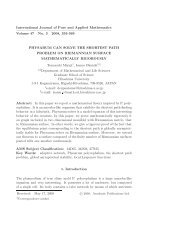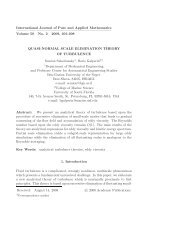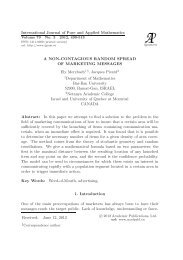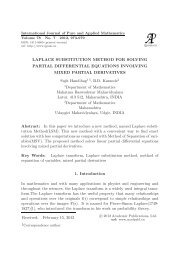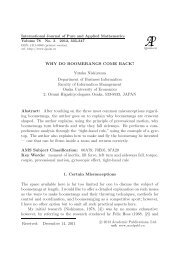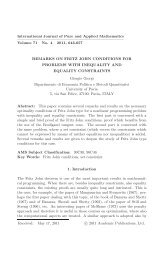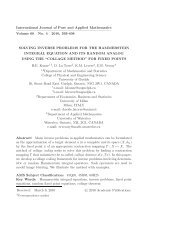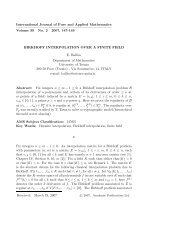FINDING N-TH ROOTS IN NILPOTENT GROUPS AND ...
FINDING N-TH ROOTS IN NILPOTENT GROUPS AND ...
FINDING N-TH ROOTS IN NILPOTENT GROUPS AND ...
You also want an ePaper? Increase the reach of your titles
YUMPU automatically turns print PDFs into web optimized ePapers that Google loves.
<strong>F<strong>IN</strong>D<strong>IN</strong>G</strong> N-<strong>TH</strong> <strong>ROOTS</strong> <strong>IN</strong> <strong>NILPOTENT</strong> <strong>GROUPS</strong>... 581<br />
⎛ ⎞<br />
9 1 0<br />
Example 4.3. Let T = J3,9 = ⎝0<br />
9 1⎠.<br />
Find the square root of T.<br />
0 0 9<br />
We have c = 9 and compute N = J3,0<br />
9 =<br />
⎛ ⎞ 1 0 9 0<br />
⎝ 1 0 0 ⎠, 9 N<br />
0 0 0<br />
2 ⎛ ⎞ 1 0 0 81<br />
= ⎝0<br />
0 0 ⎠<br />
0 0 0<br />
and N3 = 0. Then √ ⎛⎛<br />
⎞ T =<br />
1 0 0<br />
3⎝⎝0<br />
1 0⎠<br />
+<br />
0 0 0<br />
1<br />
⎛ ⎞ 1 0 9 0<br />
⎝ 1<br />
2 0 0 ⎠<br />
9 −<br />
0 0 0<br />
1<br />
⎛ ⎞⎞<br />
⎛ ⎞<br />
1<br />
1 1<br />
0 0 81 3 6 −216 ⎝<br />
8 0 0 0 ⎠⎠<br />
= ⎝ 1 0 3 ⎠. 6<br />
0 0 0 0 0 3<br />
The result is similar for n-th roots; if we take<br />
A = n√ <br />
c I + 1<br />
<br />
1 1 − n N2 N +<br />
n n n 2!<br />
then A n = T = c(I + N).<br />
+ 1<br />
n<br />
<br />
1 − n 1 − 2n N3 n n 3!<br />
5. Square Roots of Finite Groups<br />
In this section, we follow the work of Abhyankar and Grossman [1].<br />
Definition 5.1. Let G be a finite group and for X ⊆ G, let<br />
X 2 = {x1x2 | x1,x2 ∈ X}.<br />
Then X ⊆ G is said to be a perfect square root of G if<br />
1. X 2 = G, and<br />
2. |X| 2 = |G|.<br />
<br />
+ · · · ,<br />
Note that since X 2 = G and |X| 2 = |G|, every element appears once in the<br />
multiplication table for X. We can then conclude that distinct elements of a<br />
perfect square root do not commute. From this observation, is is clear that if<br />
G has a perfect square root, G is non-Abelian and X does not contain elements<br />
of Z(G). We have the following lemmas that provide necessary conditions for<br />
a group to have perfect square roots:<br />
Lemma 5.2. Let G be a group with perfect square root. Then 4 divides<br />
the order of G.



